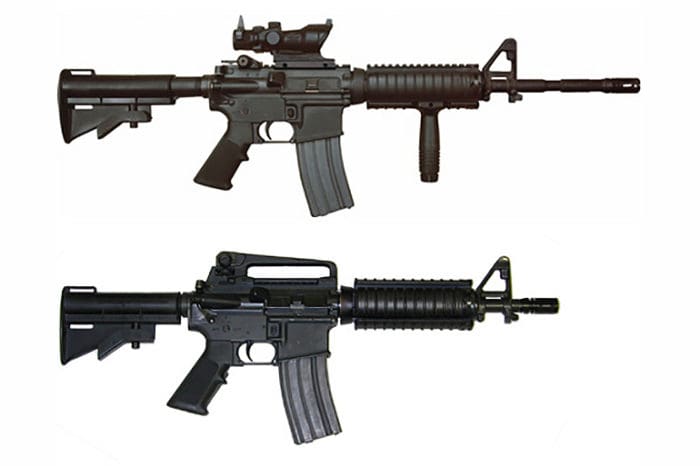In the gun realm, we are encouraged to think that anything “mil spec” must therefore be good. Reliable. Iron-clad tough, able to withstand the rigors and horrors of the battlefield.
But does it actually mean anything anymore?
Actually, it does…and it doesn’t.
Bear in mind that if you’re into collecting guns or other items because their military memorabilia value and so on…there’s nothing wrong with that. That’s a hobby, a passion, that many people have.
This has more to do with the hoopla surrounding items sold based on their alleged adherence to military standards and practices.
The US military maintains a list of requirements and specifications for materials and goods, each of which has a document outlining the pertinent specifications thereof which is literally called MIL-SPEC or “military specifications.”
What an item is made from, how it’s constructed, what it’s designed to do, etc. These documents exist for every item imaginable from capacitors to guns to truck tires to toothbrushes. There’s even mil spec underwear.
I don’t care that the Hanes I buy aren’t mil-spec. But I usually buy them in black, because that means they’re tactical.
In essence, it’s just a spec sheet that any item the military is going to use must fit. That standardizes equipment across the armed forces, which is a good idea for a whole bunch of obvious reasons.
Now…how and why does this matter to us civilians? Because we’re encouraged to think that somehow means an item is good, if not better than non-mil-spec.
Since we here are generally concerned about guns instead of, say, tent stoves, we’re talking about an AR-15, a SIG SAUER M17/P320, a Beretta M9 or other firearm issued by the military that is made to the same specifications as the models the military bought.
And people buy that stuff up, to be sure.
Much of the gun-buying public assumes, therefore, that their rifle, pistol, shotgun or what have you is therefore a paragon of rugged reliability. A bevy of AR-15 rifle makers market their products as being mil-spec or using a lot of mil-spec components, SIG SAUER sells civilians copies of the M17 pistol, and a bunch of companies produce M1911 and M1911A1 pistols.
This presumes the manufacturer is telling the truth, of course. The Army can check such things but we have to take their word for it.
Does that mean an item is any good, let alone better? I never served, so I can’t necessarily say it is or it isn’t from a first-hand perspective, but all my friends and colleagues who have served snicker grimly whenever they hear the term ‘mil-spec’ thrown around.
Consider how Uncle Sugar sources things. There’s an elaborate bidding process, where (presumably) a number of companies submit proposals (bids) and a winner is eventually chosen. Sometimes testing is involved, sometimes it’s not, depending on the product.
The presumption, of course, is that the choice of whatever it is they’re buying is made based on the item being the toughest or the best, or at least the best item when all factors are considered.
But that isn’t always what drives a military purchasing decision, is it?
Is the SIG P320 modular handgun system — used by every branch of the military — really the “best” 9mm pistol on the market? It’s an excellent gun to be sure, but “best” is very subjective.
Had one to guess, the fact that SIG SAUER bid $100 million less than GLOCK probably had something to do with the final choice. Heck, the reason the military selected the Beretta M9 over the P226 in the 80’s was allegedly because SIG SAUER was going to charge extra for magazines.
History is replete with examples of items procured for militaries that were total disasters. The Bradley fighting vehicle and the first generation of the Enfield L85A1 rifles just to name a couple.
The meat packing scandals in the late 19th century/early 20th century started over Army beef that actually killed or contributed to the deaths of soldiers serving in Cuba. (If not from food poisoning, food poisoning plus poor nutrition plus yellow fever; disease killed five times as many personnel in that conflict as combat did.)
Why did the War Department buy it? Because it was obtained at the lowest possible price. The affair inspired Upton Sinclair to write The Jungle and the government to create the Food and Drug Administration.
3M, according to Bloomberg, is currently the defendant in a class-action lawsuit by former military members who wore their hearing protection in battle as directed, but suffered hearing loss anyway. The contention is the ear protection they were issued – which, therefore, was mil spec, was defective, and didn’t work as advertised when used as intended.
So in a certain sense “military specification” is meaningful, as “mil-spec” is a real thing. How much value that designation bestows on a thing in the real world…well, you be the judge.
What do you think, though? Ever buy something because it’s “mil spec” only to find out it was junk? Or how about something turned out to be awesome? (I think some of the camping gear is pretty decent.) Sound off in the comments.
